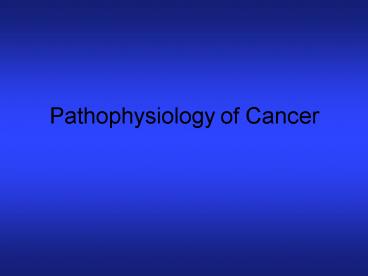Pathophysiology of Cancer - PowerPoint PPT Presentation
1 / 25
Title:
Pathophysiology of Cancer
Description:
Cancer Genetics. Tumor/Host Interactions. Clinical Application: Breast Cancer ... Differences in the incidence of breast, liver, gastric, colon and prostate ... – PowerPoint PPT presentation
Number of Views:9997
Avg rating:5.0/5.0
Title: Pathophysiology of Cancer
1
Pathophysiology of Cancer
2
- Characteristics of Cancer
- Molecular Mechanisms of Growth Control
- Cancer Genetics
- Tumor/Host Interactions
- Clinical Application Breast Cancer
3
The Nature of Cancer
4
Neoplasia Unregulated accumulation of cells
5
- Normal Tumor
- Abnormal regulation of cell growth
- Abnormal cell-cell interactions
6
Normal Tumor Normal stem cell
Cancer stem cell
7
Characteristics of Stem Cells
- Unlimited capacity for self-renewal
- Cellular immortality
- But relatively low rate of proliferation
- Capable of differentiation into the mature cells
that constitute organ function - Proliferation can be dramatic once a cell has
committed to differentiation - But differentiated cells have limited life-span
8
Normal
Cancer
Stem cell Compartment
Proliferative Compartment
Etc. Maturation Compartment
Cell loss (apoptosis)
Etc., Etc., Etc. Maturation Compartment
9
Lessons From Stem Cell Kinetics
- The growth rate of cancer cells does not exceed
that of normal cells - Abnormal differentiation of cancer cells results
in a greater percentage of cells in the
proliferative pool (at the expense of the
maturation pool) - Tumor (mass) growth exceeds normal growth due to
a higher proliferative fraction and a lower rate
of cell loss (death)
10
Benign Malignant
pleomorphism abnormal nuclei
mitoses loss of polarity abnormal
differentiation
11
Invasion
12
Abnormal cell-substratum interaction
13
Invasion into adjacent structures
14
Dissemination (Metastases)
15
Penetration of vasculature Survival in
circulation Survival in a new organ
16
metastatic spread is not random but determined
by -pattern of venous blood flow -specific
receptors on tumor and endothelial
cells -metastatic fitness is genetically
determined
17
Cancer Epidemiology
- Or,
- Guilt by Association
18
Caveat epidemiology
- Studies are observational and therefore do not
establish cause and effect - Initial observations require confirmation and
exclusion of confounding variables - However, well-performed studies can provide
valuable insights into factors that contribute to
cancer.
19
Cancer Incidence
- Cancer is a disease of aging
- Deaths increased 3x in the 7th decade compared to
the 5th 6th decades combined - But, cancers differ in their age-related incidence
20
Cancer Incidence
- Environment affects cancer incidence
- Differences in the incidence of breast, liver,
gastric, colon and prostate cancers in Japanese
and US populations disappear following
immigration (unknown factors) - Liver cancer incidence is related to incidence of
Hepatitis B C incidence and afflatoxin exposure - Melanoma incidence is associated with UV exposure
21
Cancer Incidence
- Toxins affect cancer incidence
- Tobacco - lung, upper aerodigestive tract
everything else - Asbestos - lung, mesothelioma
- Alcohol - liver, upper aerodigestive tract
esophagus, - Others - see table 7-3
22
Cancer Incidence
- Infectious agents
- H. pylori - gastric lymphoma adenoCA
- Papillomavirus - cervical CA
- HTLV - T-cell leukemia
- Epstein-Barr virus - lymphomas and nasopharyngeal
cancers
23
Cancer Incidence
- Genetic factors
- Specific cancer genes (addressed later)
- Unidentified genetic factors (generally a low
level familial risk)
24
Cancer Incidence
- Obesity increases the risk of most cancers
25
Cancer Epidemiology Conclusions
- Cancer is the result of the cumulative effects of
living and the interplay of environmental
exposures and genetic predisposition - It is likely that most risk factors act as either
Initiators or Promoters of carcinogenesis.

